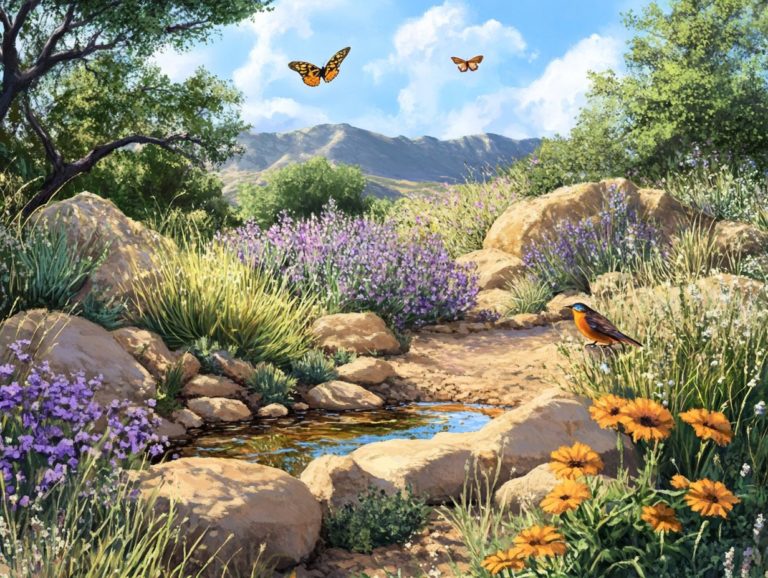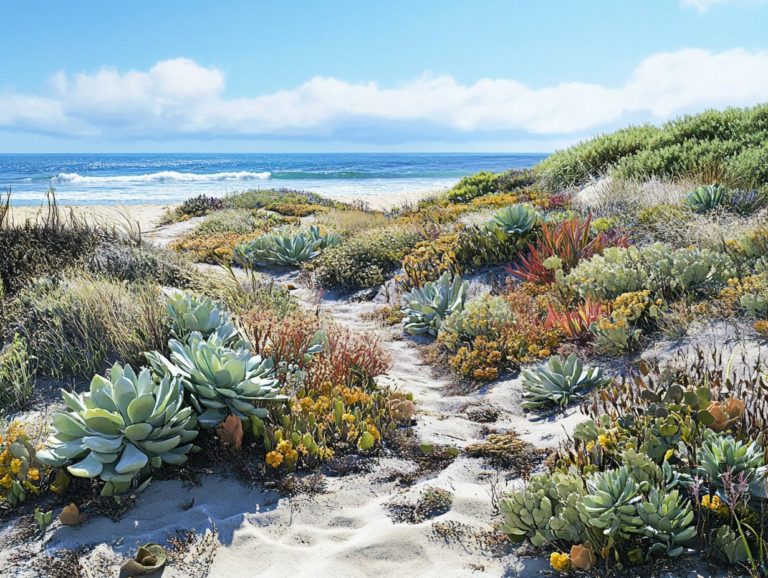What Are the Future Trends in Drought Gardening?
Drought conditions are increasingly prevalent, presenting significant challenges for gardeners like you. As climate change reshapes the environment, understanding how to adapt your gardening practices effectively is essential.
This exploration delves into the impact of drought on gardening. You ll discover effective techniques and innovative technologies designed to conserve water and promote sustainability.
From drought-resistant plant varieties to smart irrigation systems, explore current strategies and future trends that can help you thrive in this changing climate.
Navigating these vital topics equips you with the knowledge needed to succeed as a modern gardener.
Contents
Key Takeaways:

- Drought will continue to pose challenges for gardening, but innovative techniques and technologies can help mitigate its impact.
- Adopting water conservation strategies and using drought-resistant plants and soil amendments are key to successful drought gardening.
- Get ready for exciting advancements in drought gardening, including new plant breeding techniques, advancements in water collection and storage, and addressing the impact of climate change.
The Impact of Drought on Gardening
Drought influences your gardening practices. You must adjust your methods to conserve water and embrace sustainability. Understanding what tools are essential for drought gardening becomes essential as climate change continues to reshape weather patterns, especially for anyone passionate about gardening trends.
This transformation invites you to explore innovative techniques that prioritize water conservation, enhance biodiversity, and nurture the health of local ecosystems. These elements are crucial for maintaining vibrant green spaces and ensuring the sustainability of landscapes within your community.
Understanding the Challenges
Understanding the challenges posed by drought is crucial for you as a gardener striving to maintain a healthy and flourishing garden, even when water is in short supply.
Droughts are becoming more frequent due to climate change. This leads to dwindling soil moisture, which can drastically affect your plants growth and vitality. This is where effective water conservation strategies become essential. You ll need to adapt your practices to make the most of the water you have, ensuring your plants receive the hydration they need.
Employing techniques like mulch application, rainwater harvesting, and choosing drought-tolerant plant varieties can significantly lessen the negative impacts of dry conditions. Creating a xeriscape, which is a landscaping method that reduces the need for watering, or setting up drip irrigation systems are not just smart choices; they enhance both efficiency and sustainability in your gardening efforts, even in the toughest circumstances.
Current Drought Gardening Techniques
Drought gardening techniques focus on using drought-resistant plants and effective water conservation strategies. These practices are essential for ensuring that your garden remains vibrant and thriving, even under challenging conditions.
Water Conservation Strategies
Effective water conservation strategies include rainwater harvesting, graywater recycling, and utilizing soil moisture sensors to optimize your irrigation efforts.
By harnessing these techniques, you can significantly reduce your water usage while ensuring your plants remain healthy and vibrant. Rainwater harvesting allows you to capture and store rain an abundant resource so you can rely less on treated tap water for irrigation. Graywater recycling takes it a step further by repurposing water from sinks, showers, and washing machines, transforming what would otherwise be waste into a valuable resource for nurturing your garden.
Soil moisture sensors offer real-time insights into your soil conditions, enabling you to water precisely when needed, which further conserves water. Pairing these technologies with eco-friendly practices like mulching and drip irrigation creates an integrated approach to sustainable gardening, allowing you to cultivate your green oasis while being kind to the planet.
Drought-Resistant Plant Varieties

Choose drought-resistant plant varieties like native plants and ornamental grasses. They are essential for creating sustainable and vibrant gardens during drought conditions.
These resilient plants flourish with minimal water and enhance ecosystem health. For example, native succulents like Agave and Sedum require little care while offering stunning visual appeal.
Ornamental grasses, such as Blue Fescue or Switchgrass, introduce texture and movement to your garden beds. This creates dynamic landscapes that don t demand frequent watering.
The ideal growing conditions for these varieties include well-drained soil and sunny to partially shaded areas. You can easily incorporate these plants that can survive with little water into xeriscape gardens, which are designed to save water, rock gardens, or even traditional layouts.
This results in a low-maintenance yet visually striking outdoor space.
Innovative Technologies for Drought Gardening
Discover how innovative technologies can transform your drought gardening experience. These include smart gardening apps, advanced irrigation systems, and specialized soil amendments specifically engineered to retain moisture.
These tools significantly enhance your overall gardening efficiency, making it easier for you to cultivate thriving plants even in challenging conditions.
Smart Irrigation Systems
Smart irrigation systems are important tools for efficient water conservation in your garden. They leverage technology to optimize water usage and minimize waste.
These innovative systems use sensors, weather data, and automated timers to assess watering needs, ensuring every drop is utilized effectively. By integrating moisture levels, temperature, and weather forecasts, they provide tailored irrigation for your plants.
The advantages are numerous; not only do they foster healthier plants, but they also help lower your water bills and reduce environmental impact.
You can easily combine these systems with other emerging technologies, such as drip irrigation, rainwater harvesting, and soil moisture monitors. This creates a comprehensive approach to sustainable gardening practices.
Drought-Resistant Soil Amendments
Utilizing drought-resistant soil amendments can significantly enhance your soil’s moisture retention an essential factor for sustaining plant health during dry spells.
These amendments, including organic matter, compost, and specific types of mulch, create a conducive environment for roots to flourish while minimizing water evaporation.
For example, organic matter improves soil structure and boosts its ability to retain water. This is invaluable during limited rainfall. Incorporating materials such as biochar can also enhance soil aeration and drainage while effectively capturing moisture.
Embracing eco-friendly practices in soil management like crop rotation and planting cover crops further bolsters soil health. This promotes resilience against drought by leveraging natural mechanisms to enhance moisture retention.
Future Trends in Drought Gardening
The future of drought gardening focuses on innovative, climate-resilient practices, along with long-term benefits of drought gardening, innovative plant breeding techniques, and cutting-edge advancements in water collection and storage systems.
These developments empower you to tackle drought challenges head-on, ensuring your garden thrives even in difficult conditions.
New Plant Breeding Techniques

Innovations in plant breeding techniques are revolutionizing climate-resilient gardening. They empower you to select plants that flourish in an ever-changing environment.
These advancements not only streamline the process of cultivating drought-resistant plants but also enhance your sustainable gardening practices. For example, the development of native plant varieties requires less water and creates habitats for local wildlife. This approach preserves nature and bolsters biodiversity in your garden.
The emergence of drought-resistant species, such as the California lilac and various native grasses, illustrates that these cutting-edge breeding techniques can produce resilient plants. This ensures you have viable options as landscapes become increasingly arid. As climate challenges escalate, embracing these scientific breakthroughs can elevate your gardening experience into a more responsible and resilient pursuit.
Advancements in Water Collection and Storage

Advancements in water collection and storage methods, like rainwater harvesting and graywater recycling, are essential for gardeners navigating drought conditions.
These innovative techniques help conserve precious water resources and enhance the health of your soil and plants. For instance, you can seamlessly integrate rain barrels into your garden design to capture and store rainwater runoff from your roof. This stored water can be used to irrigate your plants during dry spells, ensuring they stay lush and vibrant.
Graywater recycling systems allow you to repurpose wastewater from sinks and showers, providing a sustainable source of irrigation. Coupling drip irrigation technology with soil moisture sensors ensures your plants receive the optimal amount of water without unnecessary waste.
With these advancements, you can cultivate resilient landscapes while promoting environmental sustainability, making your gardening efforts fruitful and eco-friendly.
Impact of Climate Change on Drought Gardening
The impact of climate change on drought gardening is profound, shaping gardening trends and prompting you to adopt sustainable practices. Before you begin, it’s important to know what to consider before starting a drought garden that emphasizes resilience and adaptation.
As temperatures rise and weather patterns become unpredictable, you face challenges in keeping your plants healthy. The urgency for sustainable methods is clear; innovative techniques like xeriscaping a landscaping method that reduces or eliminates the need for irrigation are essential for your gardening endeavors.
By embracing these approaches, you conserve water while enhancing biodiversity, vital for the health of local ecosystems. Incorporating organic practices and prioritizing soil health can significantly bolster the resilience of your garden, ensuring it thrives even in the face of a warming planet.
Frequently Asked Questions
What are the future trends in drought gardening?
As climate change impacts water availability, drought gardening is increasingly popular. For those interested in this topic, exploring the top questions about drought gardening can provide valuable insights. Future trends include using drought-resistant plants, xeriscaping techniques, and smart gardening apps.
How can I create a drought-resistant garden?
Creating a drought-resistant garden involves selecting the right plants and implementing water-saving techniques. Look for native plants adapted to your region’s climate and soil conditions. Incorporating mulch, using drip irrigation, and practicing rainwater harvesting can help your garden thrive during drought.
What is Xeriscaping?
Xeriscaping is a way of designing gardens using plants that don’t need much water. It’s a great way to save water in gardens and creates beautiful landscapes, especially in dry areas.
What are some smart irrigation systems for drought gardening?
Smart irrigation systems, like drip irrigation, micro-sprinklers, and weather-based controllers, efficiently water plants in drought gardening. These systems use sensors and data to adjust schedules based on weather, reducing waste.
What technological advancements are in drought gardening?
There are several new technologies in drought gardening. Examples include using soil moisture sensors to track water needs, biodegradable additives to improve water retention, and local resources for drought gardening like remote-controlled irrigation systems that you can manage via smartphone or computer.
How can I support biodiversity in my drought garden?
You can make a big difference by choosing a variety of plants that attract wildlife. Incorporating features like bird baths and insect hotels also helps support a diverse range of animals and enhances overall wildlife conservation.






